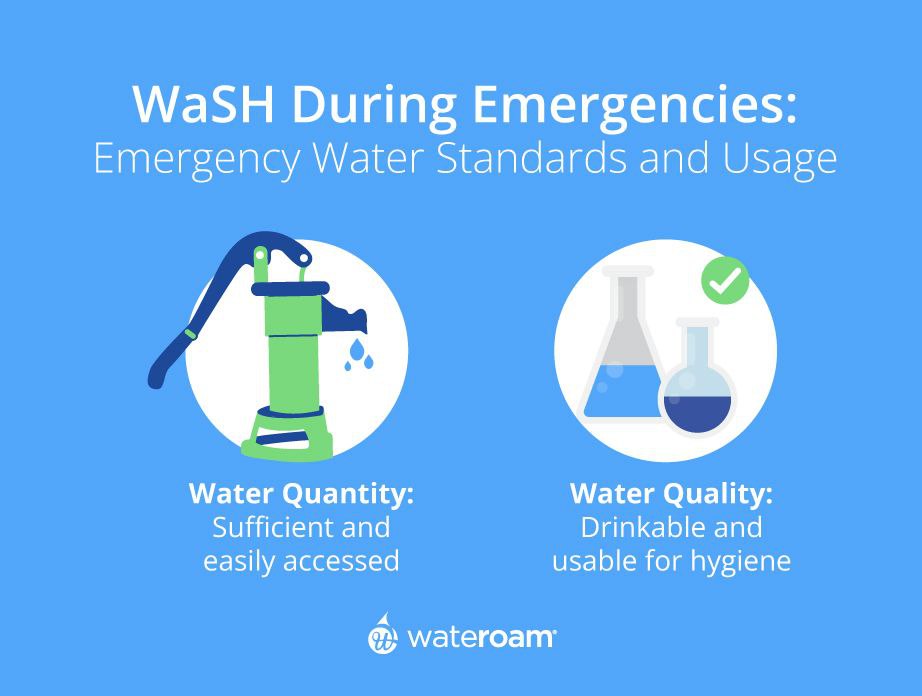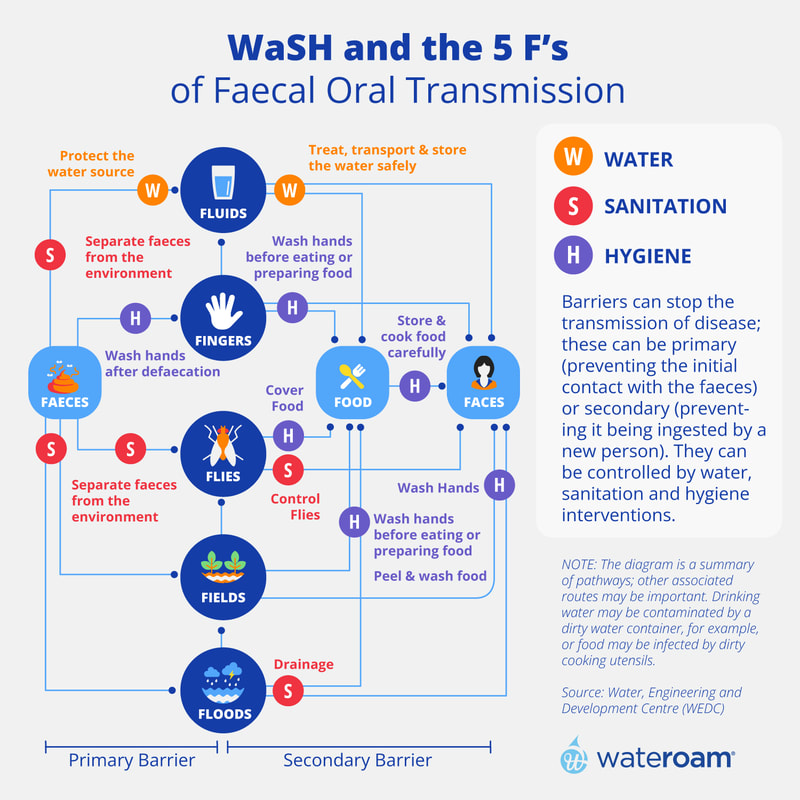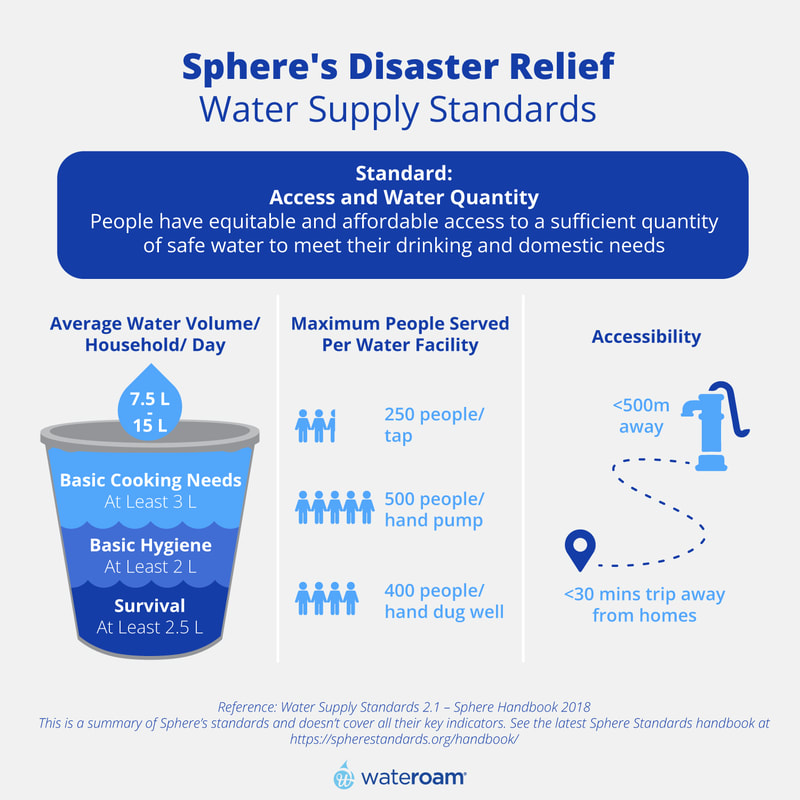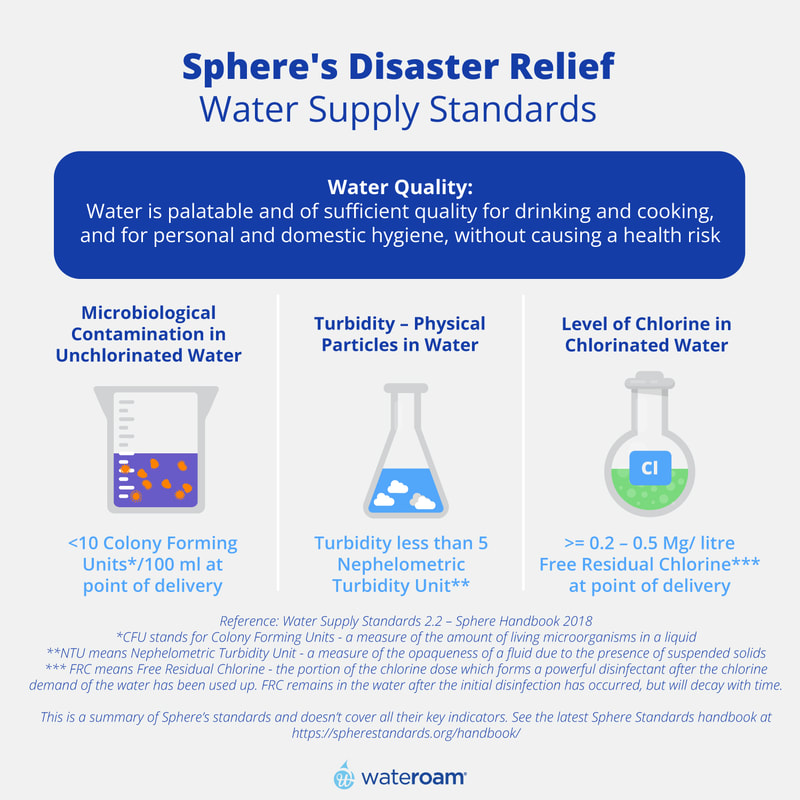WaSH During Emergencies: Emergency Water Standards and Usage
When disaster strikes, basic human necessities must be secured to prevent further loss of life.
Among these necessities is water. Without clean water, the risks of dehydration and infection from water-related diseases increases. To mitigate these risks and save lives, first responders and humanitarian organisations globally carry out water, sanitation and hygiene (WaSH) programmes. This article is to serve as an overview of Water, Sanitation and Hygiene(WaSH) fundamentals, water usage requirements, and standards and emergency water treatment during emergencies while providing links to relevant guidebooks, standards and policies that you can access below. This overview summarises and draws heavily from Unicef’s Emergency Technical Guidelines (Sudan 2017). (1) Emergency WASH Fundamentals
According to the UNICEF endorsed Sphere Handbook (2): the main objective of WaSH programmes during disasters is to reduce the transmission of faecal-oral diseases and exposure to disease-bearing vectors through the promotion of:
Sphere(3) is a movement that was started in 1997 by “a group of humanitarian professionals aiming to improve the quality of humanitarian work during disaster response.” The Sphere handbook is their flagship publication which global bodies like Unicef and UNHCR have recognised. The use of WaSH to prevent the spread of disease and dehydration is summarised in the diagram below:
To summarise the diagram, to prevent the spread of disease from faecal matter, different WaSH barriers are used:
These barriers prevent the spread of infection from the following vectors or transmission methods:
All these practices are targeted at reducing the spread of the following WaSH related diseases:
This article focuses more on water standards, usage and treatment via filtration during emergencies. If you’d like to find out more about sanitation (e.g. toilet management) and hygiene promotion activities, we recommend the following resources:
Emergency Water SupplyWater Supply Standards
Being the ‘W’ in WaSH, the provision of clean drinking water reduces infection from water-borne diseases that occur when people drink unclean and unsafe water.
The Sphere handbook has 2 water supply standards:
These are explored in detail below:
References:
*CFU (4) stands for Colony Forming Units - a measure of the amount of living microorganisms in a liquid **NTU(5) means Nephelometric Turbidity Unit - a measure of the opaqueness of a fluid due to the presence of suspended solids *** FRC(6) means Free Residual Chlorine - the portion of the chlorine dose which forms a powerful disinfectant after the chlorine demand of the water has been used up. FRC remains in the water after the initial disinfection has occurred, but will decay with time. Recommended Water Usage Amounts
During emergencies, emergency water supplies need to provide an adequate amount of water to the affected persons for drinking and other uses.
Below is the recommended amount of water per person for each household as well as the amounts needed for other usages: For households
Reference: Sphere Handbook 2018 Page 107
For medical centres
For other uses
Reference: Sphere Handbook 2018 Appendix 3
How Water Filtration Helps During Emergencies
According to UNICEF, water quality is measured in terms of having a safe microbiological quality level, safe physical quality and safe chemical quality.
Water quality is defined in terms of “microbiological contamination, chemical and physical parameters.”
Water filtration helps in terms of the microbiological and physical quality aspects of water. Water filters remove a lot of the physical solids found in water, which can interfere with the cleanliness of the water at later stages of water treatment if left unfiltered. As for the microbiological quality, water filters with small enough pores are able to remove a large quantity of microorganisms such as bacteria, helminths, protozoa, viruses and cysts by up to 99.99% or more. Filtration’s Role in Reducing Turbidity
Turbidity refers to the physical quality of the water. Turbidity, along with the other two water quality measures has to be taken into consideration when setting up the emergency water supply system. Below is what a typical bulk water treatment setup looks like that takes into account turbidity along with the water supply’s microbiological and chemical quality:
Stages:
In emergency situations, ensuring that the microbiological quality of the water is safe is vital to preventing water-borne diseases from spreading, and is controlled by disinfection and chlorination.
High turbidity affects the disinfection (chlorination) process due to the sediments floating in the water. Filtration and sedimentation are used to reduce the turbidity to 5 NTU as a pre-treatment to chlorination. There are multiple types of filtration methods: Bulk Filtration Methods:
Using filtration in conjunction with chlorination can be highly effective in reducing the presence of microbes like protozoa and helminth eggs that chlorination alone is less effective in killing. How Wateroam Helps Out
Over the years, Wateroam has been distributing its filters to locations that require disaster relief to deal with the turbidity of their emergency water supplies. Below are examples of how we’ve helped in Indonesia and the Philippines.
Lombok Earthquake Relief
2000 people reached
BGR International sent their Disaster Assessment Team to support the relief efforts after the devastating earthquakes in Lombok. Wateroam was able to provide clean water to the earthquake victims in collaboration with BGR International with four ROAMfilter™ Plus systems. As existing water sources and transport routes are disrupted and only contaminated water is available, our portable filtration systems were able to be quickly distributed and set up to support the relief effort. With the four units deployed, a total of 2000 people can be supported with 4800 litres of clean water produced daily. Due to the success of the operation, BGR International will continue to deploy another 38 systems in the following two months. You can read more about our efforts in Indonesia here. Links to Helpful Resources:Links to Helpful Resources
All the information provided in this overview only scratches the surface of what goes on during WaSH programmes during emergency situations. We’ve collected resources below for your perusal in other WaSH areas which we hope you’ll find useful:
Wateroam is always ready to support WaSH programmes worldwide with our water filters and aim to make a difference whether it’s for disaster relief or rural development initiatives. To find out more about our work and our products, reach out to us below:
(1) UNICEF - Water, sanitation and hygiene sector emergency technical guidelines for Sudan
(2) The Handbook editions and languages | Sphere Standards (3) About Sphere (4) Colony Forming Units - CFU in water bearing systems. (5) Nephelometric Turbidity Unit - an overview | ScienceDirect Topics (6) Chlorination for Water Treatment in Humanitarian Responses | Oxfam WASH Resources
0 Comments
Leave a Reply. |
Want more?Click below to see what other blog topics might peak your interest! 


|
- About Us
- Products
- Solutions
- Resources
- Get Involved
-
Blog
- The Global Water Situation
-
Facts about Water
>
- Water supplies for crisis
- WaSH During Emergencies
- Well Water Cleaning and Filtration Guide: Southeast Asia
- Gravity-fed Water Systems: Water Purification and Filtration setups in Southeast Asia
- A Guide to Rural Rainwater Harvesting and Filtering
- Water Shortages and Their Effect on Children in Rural Schools
- WaSH Planning and Design Framework Resources for Indonesia and the Philippines
- Rural Community Water Supply: Water Systems in Villages
- Info on our Products
- Impact Stories
- Upcoming & Past Events
- Contact
- Store
- About Us
- Products
- Solutions
- Resources
- Get Involved
-
Blog
- The Global Water Situation
-
Facts about Water
>
- Water supplies for crisis
- WaSH During Emergencies
- Well Water Cleaning and Filtration Guide: Southeast Asia
- Gravity-fed Water Systems: Water Purification and Filtration setups in Southeast Asia
- A Guide to Rural Rainwater Harvesting and Filtering
- Water Shortages and Their Effect on Children in Rural Schools
- WaSH Planning and Design Framework Resources for Indonesia and the Philippines
- Rural Community Water Supply: Water Systems in Villages
- Info on our Products
- Impact Stories
- Upcoming & Past Events
- Contact
- Store








.jpg)